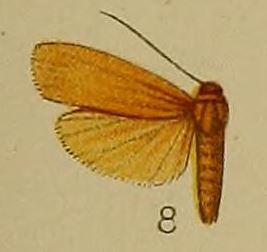
The Lymantriinae are a subfamily of moths of the family Erebidae. The taxon was erected by George Hampson in 1893.

Heliothis is a genus of moths in the family Noctuidae. It was first described by Ferdinand Ochsenheimer in 1816. Some of the species have larvae which are agricultural pests on crop species such as tobacco, cotton, soybean and pigeon pea. Some species originally in this genus have been moved to other genera, see Chloridea and Helicoverpa.

Egnasia is a genus of moths of the family Erebidae. The genus was first described by Francis Walker in 1859.

Aroa is a genus of moths in the subfamily Lymantriinae first described by Francis Walker in 1855. Species are distributed in South Africa, China, throughout India, Sri Lanka, Myanmar, and Java.
Meganola brunellus is a moth of the family Nolidae. It is found in Sri Lanka, India, Taiwan, Japan, the Ryukyu Islands, Sundaland, Queensland and the Bismarck Islands. It is an introduced species in Hawaii.

Ectomyelois ceratoniae, the locust bean moth, more ambiguously known as "carob moth", is a moth of the family Pyralidae. It has a nearly cosmopolitan distribution.

Brunia antica is a moth of the family Erebidae described by Francis Walker in 1854. It is found from the Indian subregion, Sri Lanka to China, the Ryukyu Islands, the Chagos Archipelago, the Nicobar Islands and Sundaland.

Euzophera is a genus of snout moths. It was described by Philipp Christoph Zeller in 1867.

The Phycitini are a tribe of moths of the family Pyralidae.
Euzophera albicostalis is a species of snout moth in the genus Euzophera. It was described by George Hampson in 1903. It is found in Russia, India and Iran.
Euzophera bigella, the quince moth, is a species of snout moth in the genus Euzophera. It was described by Zeller in 1848. It is found in most of Europe, Iran, Baluchistan and Morocco.

Euzophera cinerosella is a species of snout moth in the genus Euzophera. It was described by Zeller in 1839. It is found in most of Europe, Turkey, Russia and China.

Euzophera fuliginosella is a species of snout moth in the genus Euzophera. It was described by Hermann von Heinemann in 1865. It is found in most of Europe, except Great Britain, Ireland, Norway and the western part of the Balkan Peninsula.
Euzophera osseatella, the eggplant borer, is a species of snout moth in the genus Euzophera. It was described by Georg Friedrich Treitschke in 1832. It is found in Great Britain, France, Spain, Portugal, Italy, Sicily, Sardinia, Corsica, Croatia, Greece, Cyprus, Syria, Israel and North Africa.

Euzophera villora is a species of snout moth in the genus Euzophera. It was described by Cajetan Felder, Rudolf Felder and Alois Friedrich Rogenhofer in 1875 and is known from South Africa, Madagascar and Ethiopia.
Euzophera aglaeella is a species of snout moth in the genus Euzophera. It was described by Ragonot in 1887, and is known from Arizona.

Euzophera perticella is a species of snout moth in the genus Euzophera.









